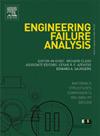RC T-beams with flexural strengthening in the negative moment region under different configurations of NSM CFRP rods
IF 4.4
2区 工程技术
Q1 ENGINEERING, MECHANICAL
引用次数: 0
Abstract
This study employed a near-surface mounted (NSM) technique to enhance the flexural performance of reinforced concrete (RC) T-beams in the negative moment region, using carbon fiber reinforced polymer (CFRP) rods embedded at varying depths. An experimental investigation was conducted, supported by analytical calculations and finite element (FE) simulations, to validate the results. The experiments revealed that beams with half-embedded CFRP rods experienced partial debonding at significant crack locations, a problem potentially mitigated by fully embedded rods. Strengthening with NSM-CFRP rods increased cracking, yield, and ultimate loads by 10–21%, 36–38%, and 30–40%, respectively, compared to control beams, while also enhancing stiffness. However, these methods may have a twofold impact on the specimen by decreasing its ductility and energy absorption capacity. The analytical approach provided accurate and conservative predictions, with a coefficient of variation of 4.5%, while the FE model demonstrated high accuracy, achieving a coefficient of variation of 3.5% when compared to experimental flexural load capacity results.
求助全文
约1分钟内获得全文
求助全文
来源期刊

Engineering Failure Analysis
工程技术-材料科学:表征与测试
CiteScore
7.70
自引率
20.00%
发文量
956
审稿时长
47 days
期刊介绍:
Engineering Failure Analysis publishes research papers describing the analysis of engineering failures and related studies.
Papers relating to the structure, properties and behaviour of engineering materials are encouraged, particularly those which also involve the detailed application of materials parameters to problems in engineering structures, components and design. In addition to the area of materials engineering, the interacting fields of mechanical, manufacturing, aeronautical, civil, chemical, corrosion and design engineering are considered relevant. Activity should be directed at analysing engineering failures and carrying out research to help reduce the incidences of failures and to extend the operating horizons of engineering materials.
Emphasis is placed on the mechanical properties of materials and their behaviour when influenced by structure, process and environment. Metallic, polymeric, ceramic and natural materials are all included and the application of these materials to real engineering situations should be emphasised. The use of a case-study based approach is also encouraged.
Engineering Failure Analysis provides essential reference material and critical feedback into the design process thereby contributing to the prevention of engineering failures in the future. All submissions will be subject to peer review from leading experts in the field.
 求助内容:
求助内容: 应助结果提醒方式:
应助结果提醒方式:


